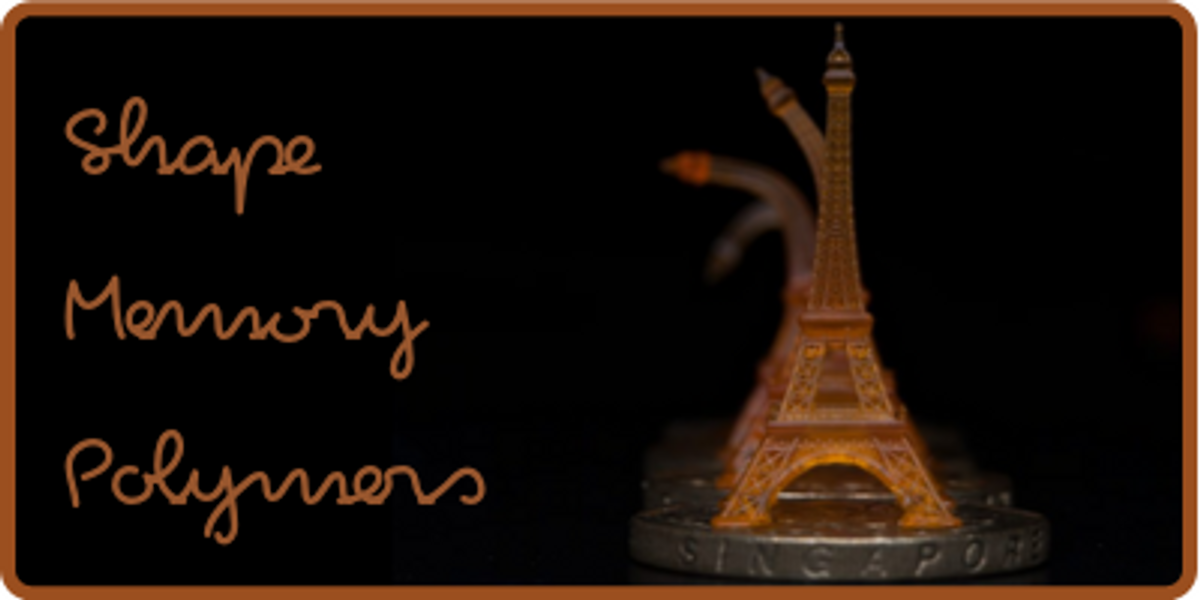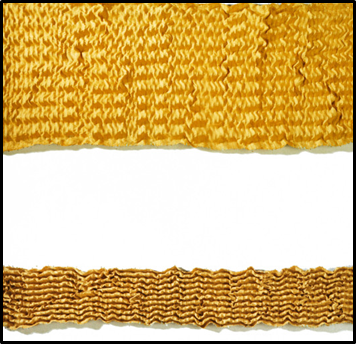Shape Memory Polymers: Properties, Production, Types, Uses, Examples
Shape Memory Polymer belongs to the class of smart materials and are defined as those polymers that have the ability to return from a deformed state (temporary shape) to that original (permanent form) through an external stimulus. By modifying their three-dimensional structure in response to precise external stimuli, shape memory polymers allow the creation of devices with complex and miniaturized morphologies. Although the shape memory metal alloys were the first to be developed, the evolution of polymers allowed them to quickly establish themselves in the segment, so much so that the first commercial application dates back to the 1960s, with the production of cross-linked polyethylene (PE) heat shrink to be used as a pipe cover.

Heat Shrink Tubes.
"The first commercial application dates back to the 1960s, with the production of cross-linked polyethylene (PE) heat shrink to be used as a pipe cover."
In this article, we’ll look at the production, properties, importance and applications of Shape Memory Polymers.
How Shape Memory Polymers are produced?
We have seen how shape memory is activated in the case of metal alloys. From this point of view, polymers are able to show enormous versatility, so much so that materials activated by heat, electric current, application of forces, light radiation and hydration have been developed.
In addition to the different types of activation, the versatility of the polymers is also due to the fact that the shape memory can be obtained both on thermoplastic and thermosetting polymers, using crosslinked polymers, block copolymers or blends or IPN (Interpenetrating Polymers Network), all loaded with fibers and/or reinforcements. However, despite the multiplicity of structures and mechanisms of action, the commonly used shape memory systems are of the copolymer or crosslinked type, and the most common activation is the thermal type; in this case, the "switch" temperature between the two phases characterizes the behavior of the materials. For example, a material that has a Temperature switch of 60 °C can be deformed in the temporary form (or vice versa, allowed to relax to return to the original shape) when heated above 60 °C.
As already mentioned, the possibility of having temporary and permanent forms is linked to the simultaneous presence in the material of two phases. When the shape memory property has thermal activation, one phase has a higher transition temperature and the other lower. The first one - usually a crystalline phase, also called "hard phase", able to melt the material - allows to permanently modify the polymer, but only if it is brought to a temperature higher than the transition temperature of this phase.
The temporary form, which takes the name of "soft phase" is, on the contrary, easily variable at low temperatures and is linked to a phase, usually amorphous (but not always), present in the material. When this phase is amorphous, it is the glass transition temperature (Tg) that is used as a thermal switch; this temperature is called temporary temperature (Ttemp). The process of modifying the temporary shape occurs at a temperature higher than the Ttemp but lower than the Tperm.
The material acquires sufficient mobility to be molded and, once it is brought back to a temperature lower than Ttemp, it is able to maintain the shape imposed during the processing. At this point, if the specimen is brought back to a temperature higher than Ttemp but lower than Tperm, a spontaneous and rapid reacquisition of the original polymer form is observed. The process is theoretically repeatable for infinite cycles, however after a certain number of cycles, there is a loss of recovery of the permanent form.
Polymers with Shape Memory Properties
The hard phase of the material can be constructed using any polymer with a relatively high transition temperature. Thanks to the extreme versatility in terms of synthesis and properties, polyurethanes are the polymers most used to obtain SMP. By varying the type of diisocyanate and the diol materials, extremely variable mechanical and thermal properties can be obtained, in which the urethane phase is generally the hard phase, while the polyol or polyester is the soft one.
PEG (polyethylene glycol) or poly-ɛ-caprolactone, whose glass transition temperatures are around 40-60 °C, are widely used to obtain soft phases with Ttemp slightly higher than the ambient ones or those of the human body. If you want to operate at lower switch temperatures, polyethylene adipate or polytetrahydrofuran is used. These systems, in fact, have transition temperatures below 0 °C.
There are also examples of SMPs consisting of olefinic copolymers based on 1,4 butadiene and styrene: in this case, the hard phase is constituted by the polystyrene phase, while the soft phase by the polybutadiene crystalline system. In this case, the Ttemp is due to the fusion of the polybutadiene and not to a glass transition, demonstrating that it does not matter what the transition is, but that there are two distinct thermodynamic phenomena.
In addition to those listed, many other polymers may have shape memory properties.
Importance of Shape Memory Polymers
Shape memory polymers are novel materials that exhibit intelligent behavior when exposed to an external stimulus, so they have aroused great interest. Recent research demonstrates innumerable and possible applications, thanks to the low cost and high deformability and recovery capacity that characterizes these materials.
The ability of polymers to modulate, more precisely, this shape retention feature, makes them more versatile to achieve intelligent materials for defined applications. Some examples, where these materials have been used are in implantable biomedical devices, preparation of electroconductive and magnetic composite materials, in textile applications and in the preparation of coatings for metal corrosion, among others.
Recently it has been investigated that shape memory polymers derived from epoxy resins have found a wide scientific and technological interest because they are cheap, have excellent physical and mechanical properties and, in addition, it is easier to modulate their recovery properties.
One of the studies carried out at the Applied Chemistry Research Centre was the chemical modification of an aromatic epoxy resin for wide commercial use. Said resin is characterized as a high-performance material. Thanks to its high reactivity, it has a wide variety of applications, mainly in coatings. This type of epoxy resins gets hard in the presence of a curing agent also known as crosslinking agent. Amines are generally used to achieve crosslinking. As a result, the material possesses high rigidity.
One of the recent investigations have achieved a new shape memory polymer from the chemical modification of the commercial epoxy resin, by means of new curing agents of the allylamine type, adding a compound of the thiol type. For a polymer to have the shape memory capacity, it is necessary that it has two phases: a hard one that helps it retain the original shape of the material, achieved by covalent bonds containing the epoxy resins. On the other hand, a soft phase is required, which helps to maintain the transient shape of the material, which can be achieved through allylic groups derived from the new curing agents.
The polymers obtained with the new hardeners have a good shape memory capacity, which is measured by the flexion or crease-unfolding and torsion tests. In both evaluations, the polymer undergoes great deformations. In addition, equipment was developed and adapted to perform this type of tests, obtaining good results in terms of the recovery of the original form of the new polymers.
The importance of epoxy resins for SMP is mainly that they are used in a wide variety of protective and decorative coatings due to their good adhesion, mechanical and chemical resistance. They are applied mainly in coatings of cans and drums; coatings for car and cable paint. In the electrical industry, they are used because they are capable of preserving their properties in wet places or with high humidity; Typical applications here are high voltage insulators, switches and transistor encapsulation. They are also used to make laminates and matrix materials with reinforced fiber.
Applications of Shape Memory Polymers
The fields of application for SMPs are manifold, although, the high cost and the high specificity of the material make them today particularly appreciated in the biomedical field.
1. Shape Memory Polymers in Orthodontics
There are numerous examples in which they replace metal wires in orthodontics: although the polymeric thread has mechanical properties of resistance to stress and fatigue lower than that of metal, it has a much lower aesthetic impact, increasing patient satisfaction.
2. Shape Memory Polymers in Bandages
Shape memory materials have also been used for the production of rigid bandages able to adapt perfectly to the patient's skin, also presenting the advantage of being completely recyclable and transparent to X-rays.
3. Shape Memory Polymers in Suture Threads
Self-shrinking suture threads have also been developed, able to bring the edges of a wound closer in a few seconds: the wire undergoes an extension of over 200 percent of its length when hot, while once applied, it is able to withdraw in just 20 seconds. Furthermore, the thread is made of bioresorbable material and therefore, once healing is complete, the patient's body automatically eliminates the stitches.
4. Shape Memory Polymers in the Treatment of Cerebral Aneurysms
Systems built with shape memory materials are also used for the treatment of cerebral aneurysms, generally treated with platinum spirals: the metal has no affinity with the organism and leads to a fairly high failure of the implants, whereas if the spiral is constituted from a biomaterial, the treatment is more effective.
5. Shape Memory Polymers in Window Blinds
Researchers from the Institute of Biomaterial Science (Department of Helmholtz-Zentrum Geesthacht in Germany) have developed a polymer that can change its shape based on temperature changes. The image represents a blind window, whose slats are closed or opened in relation to the environmental conditions; users can program the temperature range in which the slats move.
6. Shape Memory Polymers in Packaging
In addition to biomedical, SMPs are used in more common areas, for example in packaging. PE or crosslinked self-tightening PET, under thermal stimulation, adhere perfectly to the size and shape of the product.
7. Shape Memory Polymers in Self-Tightening Tubes
In the same way, self-tightening tubes are produced that can adapt to the ducts and prevents leakage.
8. Shape Memory Polymers in Textile Industry
In the textile field, mixed cotton or wool yarns and shape memory polyurethanes are obtained, capable of being reshaped at a temperature higher than the transition temperature of the material, so as to customize the product for the customer to the extreme.
Shape memory polymers have also been used for the production of underwear: the possibility of modeling the head on the forms of the human body greatly improves the comfort given by the product.
Summary
The possibilities of research and developments have resulted in the production of Shape memory polymers. Shape Memory Polymers are manipulated at the molecular level to change their shape in response to a stimulus called activator. They offer the market of polymers with very interesting shapes. Shape memory polymers are the subject of intense research. Their commercial use is likely to be first in medical technology, where metallic shape memory materials are already playing a role today. Besides the replacement of traditional materials, they can be used for innovative and high-tech applications. Among the shape memory polymers available today, we find both thermoplastic and thermosetting systems. In the future, Shape Memory Polymers will unleash more innovative applications in different sectors.
Recent Posts
-
Advanced Materials for Unmanned Aerial Vehicle (UAV) Protection Against Laser
Consider a UAV on a critical mission, rendered inoperative by a sudden laser attack. With the increa …26th Jul 2024 -
Simulation and Modeling of Material Properties
Our world is composed of a dazzling array of materials, each with its own unique properties that dic …19th Jul 2024 -
Advanced Coatings for Superior Corrosion and Wear Resistance
Corrosion and wear pose significant challenges across various industries, leading to substantial eco …12th Jul 2024






